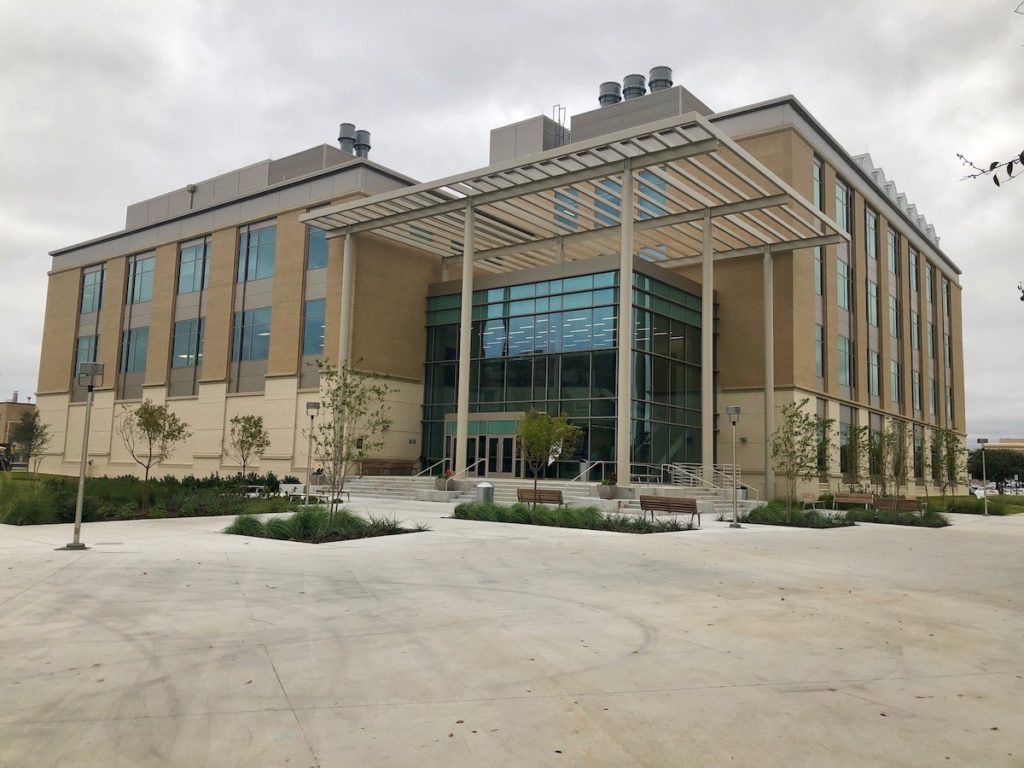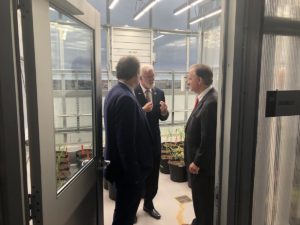Texas A&M AgriLife opens new Plant Pathology and Microbiology building
State-of-the-art building will advance the understanding of plants and their microbiome
 Texas A&M AgriLife hosted a grand opening of the Department of Plant Pathology and Microbiology building on Texas A&M University’s West Campus on Oct. 25. This building will be the new home to advance the understanding of interactions between plants and their microbial community, or microbiome.
Texas A&M AgriLife hosted a grand opening of the Department of Plant Pathology and Microbiology building on Texas A&M University’s West Campus on Oct. 25. This building will be the new home to advance the understanding of interactions between plants and their microbial community, or microbiome.
As agriculture works to produce more food and fiber while using less land, water and agronomic inputs, this new state-of-the-art home for Plant Pathology and Microbiology will move solutions forward for Texas A&M and the College of Agriculture and Life Sciences.
“Our faculty, staff and students of this department, this college and our agencies, their work will revolutionize our food system to nourish and protect the world,” said Patrick Stover, Ph.D., vice chancellor of Texas A&M AgriLife, dean of the College of Agriculture and Life Sciences and director of Texas A&M AgriLife Research. “The research, education and outreach that happens in these buildings and beyond, will help nourish our civilization. I am really proud to be a part of that and to see Texas A&M be a leader to further that role.”
With a motto of “Healthy plant, healthy planet, healthy people,” the department’s faculty members conduct research on all aspects of plant health and microbiology, including plant diseases, harmful and beneficial plant microbe interactions, and plant health management.

The building will provide 84,000-square-feet of space for new offices, classrooms and laboratories, including the Molecular Biology of Plant Defense Responses Research Lab, Molecular Epidemiological Modeling of Plant Pathogen Spread Lab, Fungal Development Biology Research Lab, Environmentally Controlled Plant-Microbe Growth Chamber Facility and Greenhouse Facility.
Research programs will focus on plant pathogenicity, plant signaling, plant-microbe interactions, synthetic biology and biofuels, and plant biotechnology. Texas A&M AgriLife Extension Service programs are located across the state at six Texas A&M AgriLife centers, and the department operates two plant disease diagnostic facilities, the Texas Plant Disease Diagnostic Lab in College Station and the High Plains Diagnostic Lab in Amarillo. These diagnostic labs lead efforts to rapidly identify invasive plant pathogens coming into Texas.
“This is an exciting day in the life of the university,” said Michael Young, president of Texas A&M University. “It is a reflection of a tremendous vote of confidence to one of our great colleges and the work that goes on here. This university, with the work of Dr. Borlaug and the College of Agriculture, has probably saved more lives than anything else in history. This building is a monument to the work that has gone on before but also represents a look into the university’s future of what will happen here.”
The building also houses the Systems and Synthetic Biology Innovation Hub and faculty associated with the Center for Phage Technology. The Department of Plant Pathology and Microbiology offers undergraduate and graduate programs that lead to rewarding careers related to plant pathology, microbiology, plant-microbiome interactions and environmental science.
“This building is the future and will be the place where the world seeks the true science of nutrition and nutrition from plants,” John Sharp, chancellor of the A&M System. “It is going to be a perfect marriage between what’s good for folks and what is good for producers. This is an outstanding addition to the ‘A’ in Texas A&M University.”
The department is ranked fifth nationally for plant pathology programs and has graduated more than 30 doctoral and 23 master’s students during the last five years. The bioenvironmental sciences program is the largest undergraduate program among plant pathology departments in the U.S.

“These modern research laboratories, state-of-the-art growth chambers and rooftop greenhouses will greatly increase our ability to compete and perform world-class research in plant pathology,” said Sandy Pierson, Ph.D., department head for plant pathology and microbiology.
“We look forward to serving the citizens of Texas, and the world, by addressing existing issues and preparing for agricultural and environmental threats to allow Texas to grow economically while maintaining environmental sustainability.”


